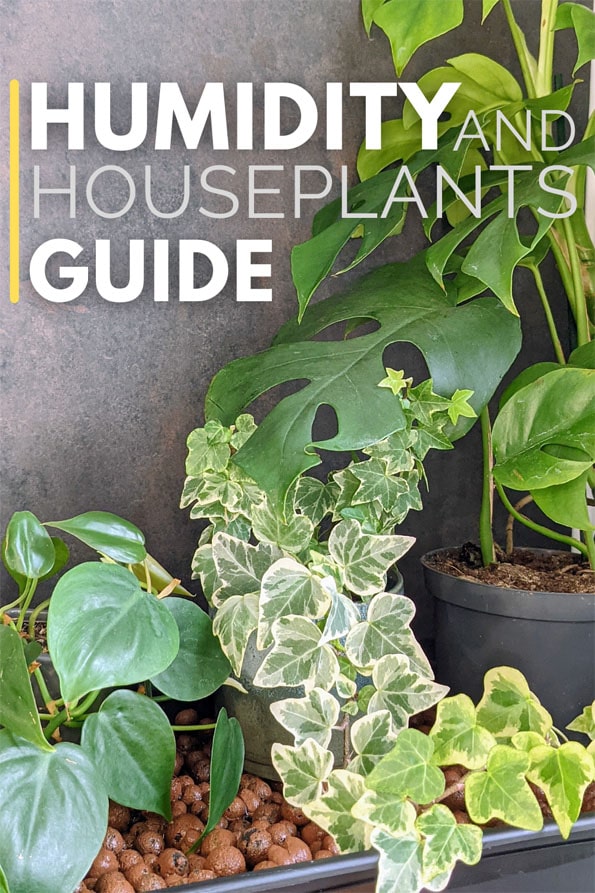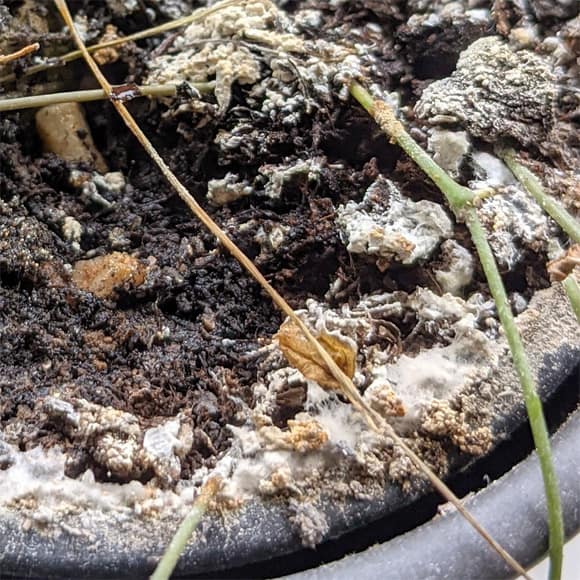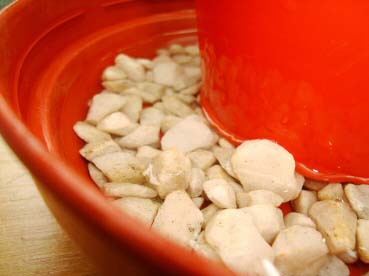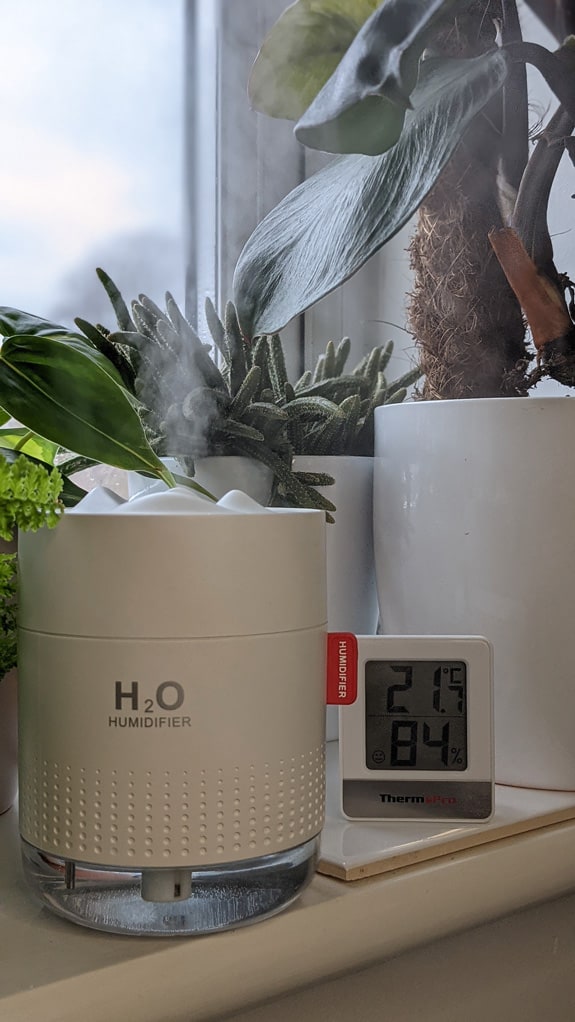Put simply, humidity is the concentration of water vapor present in the air. Once this concentration is measured, we can classify the result as a High, Average, or Low humidity level. The higher the humidity level, the more water vapor is in the air.
Humidity in the home is one of the hardest things to get right because it's usually outside your control. Even if you strike that perfect level, it's tough to maintain constantly.
That's the bad news.
The good news is that, humidity for many houseplants isn't that important because most people already live in homes that are suitable to grow indoor plants well. And if you don't, there are easy things you can do to fix it.
Creating a more humid environment: Houseplants growing on a pebble tray.
So how does Humidity work? On a basic level, moisture is extracted from any material exposed to dry air (or "low humidity"). As an example, this is why washing dries when you put it on the line outside.
Fortunately, in most cases, humidity for many houseplants isn't that important.
On a bright warm sunny and slightly windy day the washing will dry very quickly, because the air is dry and the humidity is low. The moisture is easily extracted from your clothes and away into the surrounding air.
You'll notice that if the day is particularly "damp", it takes longer for washing to dry and even then may not dry completely, on days like this the humidity is high. There is already lots of moisture in the air, so it takes longer to pull it out of your washing.
If the average indoor plant is growing in low humidity, water will be more easily taken away from the plant's leaves through transpiration, like the washing outside example.
Plants depend on this water to maintain photosynthesis. So in most cases, it will result in the plant's roots taking up more moisture to replace the loss. This results in the soil drying out quicker and you needing to water it more.
If the water loss is too significant for the plant to replace in time, then your plant will start showing problem symptoms.
Signs of low humidity in plants include crispy brown leaf edges, brown tips, yellowing leaf drop and in some cases, flower buds falling off. Over long periods, your plants will start to look pretty awful before failing completely.
Too much humidity can cause mold to grow on the top of house plant soil
On the flip side, if the humidity is high for an extended period, you will avoid the above problems (yay!), but instead attract fungal disorders, white mold on the surface soil of houseplants, rotting and certain pests (boo!).
All of those things relish such damp conditions and you'll have to deal with a new set of issues. Additionally when the humidity is high, overwatering can be a real problem as the growing medium will stay wet for far longer.
All of this means that you will need the correct balance for most plants, not too low and not too high. Think of it like the Goldilocks equivalent, but for plants.

Hi, I'm Tom!
If you're like me and enjoy the challenge of growing houseplants and getting them to thrive, then Ourhouseplants can help. This website shares my knowledge and years of growing plants and provides (hopefully) helpful advice on properly caring for your indoor plant friends.
Rather than being at a fixed level, the humidity in homes tends to vary through the year. Between High, Average (or "Medium") and Low.
How can you measure Humidity?
Easy! You just need a Hygrometer. The one we use, which you can see in some of our photos, can be brought from Amazon here. (This is an affiliate link. If you decide to buy one, we will receive a small commission which helps pay for our website).
The most important deciding factor is generally the ambient temperature.
Typically, as the temperature gets higher, whether that's because it's Summer or because you have a fire or central heating going, the humidity will be lower. The opposite is true when the temperature is cooler.
Here is what the three levels mean in practical terms.
High humidity will occur either when the temperatures are lower (more water vapor lingers in the air) or when it's artificially created.
This could occur in (or close to) a humid room like bathrooms, kitchens and laundry rooms because these places have running hot water from bath, showers, cooking, etc. This creates steam and moisture.
Fortunately, the bathroom or kitchen would rarely be saturated with so much steam that severe problems with your living area occur. However, there would still be enough to make these places ideal for plants needing higher humidity levels.
Many tropical plants will be quite at home with high moisture levels. These will include ferns like the Boston Fern or Staghorn. Maranta and Calathea like it too as they can be very fussy and demand higher levels to really perform and avoid brown leaf edges. Air Plants and some Orchids are another easy pick.
Many rare and unusual plants also need higher levels. This would include unusual Alocasia and Philodendron varieties. (Don't panic if you have one from a cheapie box store! Most common houseplants do perfectly well in average levels. It's usually the rare and specialist varieties you need to be careful with).
If you're fortunate enough to live in a home with an average humidity level for much of the time (between 40% - 60%), you might not have "fix" anything. But if your levels are at either end of the scale or your plants are suffering, there are some things you can do. We cover them later in this article.
As for suitable houseplants, you can generally grow anything within this range, but again some plants will be a little more demanding and might need some help to thrive.
Low humidity is sometimes a big problem during the winter months because most homes have central heating or fires that dry out the air considerably.
A small consolation here is that houseplants don't grow very much in the winter months or are instead in a rest/dormancy period, so they don't need as much water. Therefore dryness at the roots and low humidity for short periods isn't usually a massive problem at this time.
You may also live in a part of the world that gets very hot summers or long term dry conditions. You might use an air conditioner to try and cool things down which can then cause a dry home. Even if you don't address the underlying issue, you can still grow some popular houseplants.
Almost any cacti or succulent will cope with low humidity easily. They have special adaptations to deal with these conditions and will be entirely at home in environments like this.
A few low humidity plant examples would be Aloe Vera, Echeverias, Euphorbias like the African Milk Tree, most Haworthias and Gasteria will do perfectly well. Not forgetting the ever popular Snake Plant.
Let's say you have a problem with low humidity or noticed your indoor plants are suffering because they need higher levels; what can you do to increase it?
Place washed gravel / sand / pebbles or even LECA (Lightweight Expandable Clay Aggregate) in a large shallow water filled tray. Then put the plant pot on top. This allows a small amount of water to sit below the pot that the plant's roots can't absorb.
Instead, the water gradually evaporates and boosts the humidity surrounding the plant. It's really important not to let the pot sit in the water, though, as this will encourage the roots to rot.
A humidity tray can be and easy way to help keep your plants healthy by adding extra humidity to the surrounding area.
By far, the easiest solution for temporary low humidity levels is misting. It's just a case of buying a spray bottle and frequently misting the plant.
If the temperature is high you may need to mist several times a day. It's not a long term fix, though and the benefits are limited.
This will only create short term humid conditions. If you intend to use misting as the sole means to deal with this problem, read the article linked below.
Further reading -
Does misting actually do anything?
If you group several houseplants close together, they will naturally increase humidity. You can see an example of this in the first photo in the article right at the top.
Again the returns you get from doing this aren't always brilliant, and it does mean you have to position your indoor plants in ways you might not want to.
A humidifier is the number one best way to increase moisture in the air. It's consistent and efficient and probably the least time-consuming method. You fill up a humidifier with water and run it for several hours a day. That's it.
A humidifier will add moisture to the air. Like plants, many people don't like constantly dry air either, and humidifiers can alleviate a variety of human health issues at the same time.
A small one like the one pictured below will increase humidity around the area by a few feet. So it won't benefit the entire room if it's enormous.
This could be a plus because it will prevent high humidity problems, but it could be a negative if your plants are spaced out throughout the room. A larger machine with a higher output could be the solution in these situations.
This humidifier from Amazon can really help create a tropical climate and prevent dry environments. A Hygrometer, also from Amazon lets you monitor the levels.
This is one of our current setups and so far things are working out well. It only reaches that 84% level occasionally when running continuously for hours. It usually settles around 70%, ideal for these particular plants.
What can you do when you've noticed a lot of problems associated with high humidity such as mold on the soil of your houseplants, rotting and various pests?
It's unusual for areas of the home to be very humid and stale if good ventilation is provided. In winter, however, this can be an issue as most ventilation comes from opening a window, which you might not want to do at this time of your year!
If you can't increase ventilation, try the following:
Don't add extra moisture to the surrounding area. Take extra care when you water. Spend a few additional minutes to make sure you haven't over watered the plant, drain off any excess water collecting in its drip tray, etc.
Think about moving the plant to a drier place in the home, even if it's just for a few months over the Winter season.
If the above isn't helping or can't be done, you could consider investing in a dehumidifier.
These machines remove moisture from the air, keeping your plant happy, but also removing problems from your home associated with high humidity, such as mold and fungus growing on your walls and ceilings.
Depending on how big your space is, you can typically find a good selection of these machines on eBay.
Generally speaking if a plant is sold as a "houseplant" it tends to be suitable for average conditions found in homes.
However, more exotic and demanding "houseplants" from tropical regions have appeared on the market over the last few years. Some of these will either struggle in average humidity levels or flat out won't put up with it. Even a 60% relative humidity level might not be enough.
What level of humidity does my plant want?
Head over to our houseplant profile hub. Find your plant and then look at the Care section, which will tell you what it needs.
We've clearly outlined why excessively high levels all the time can be damaging to you and also your home. So if you want to grow some of these challenging but amazing plants, the solution is to create areas in your home that can "contain" and isolate these high levels from the rest of your living spaces.
Bottle gardens, terrariums are a popular method to do this, but only really work with smaller plants. So if these things are too small, you can create a much bigger growing space and combine ideal growing conditions with something beautiful by allowing you to display and show off these plants.
The IKEA Greenhouse "hack" lets you do just that and is very popular with many houseplant enthusiasts.
I've not personally done this yet, but it's something I'm thinking about doing. If you've done it already, get in touch. I would love to see your setup and hear your experiences.



